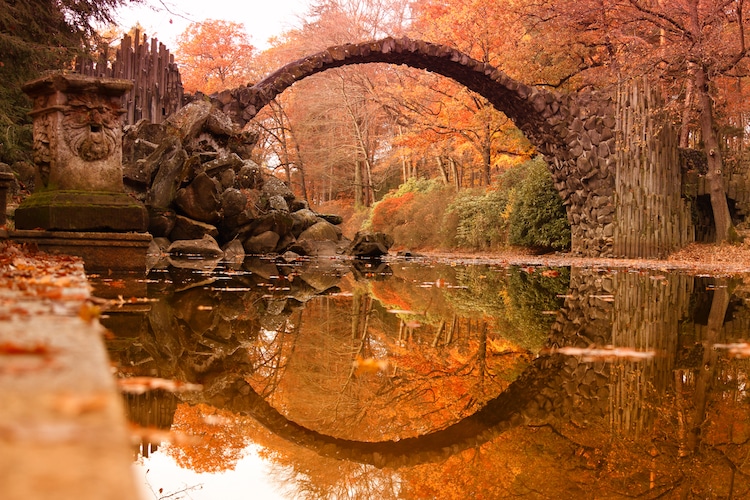At first glance, it looks as though nature has created a perfect circle that frames the gorgeous landscape of Germany’s Kromlauer Park. But look a little longer and you’ll realize that this stunning sight is the result of a clever optical illusion. An arched bridge called Rakotzbrücke, or devil’s bridge, is responsible for fooling your eye.
Rakotzbrücke was commissioned by a knight of Kromlau and completed in 1860. The rustic and natural-looking circle bridge was constructed using different types of stone with pointed rock spires that punctuate either end. It was specifically designed with the optical illusion in mind.
So, why is the Rakotzbrücke called devil’s bridge? There’s nothing inherently evil about it, but this nickname speaks to its awe-inspiring form. The folklore term was given to any bridge—but primarily ancient ones—that showcased a great achievement in engineering—so magnificent, in fact, that it must’ve been created by the devil rather than a mere mortal.
With its fantastic panoramic views, Rakotzbrücke is a popular place for bridge photography. You too can visit this locale, but beware: walking on this bridge is prohibited in order to preserve it for generations to come.
Located in Kromlauer Park in Germany is the Rakotzbrücke, or devil’s bridge.

Photo credit: Mike Mareen / Shuttertstock

Photo credit: Lukasz Stefanski / Shutterstock

Photo credit: Dirk Förster
It was constructed in 1860 with a grand optical illusion in mind. When the bridge is reflected into the water, it, it makes a perfect circle.

Photo credit: Henning Herrmann

Photo credit: Mike Mareen / Shutterstock

Photo credit: A.Landgraf
The gorgeous panorama views have become a popular spot for bridge photography.

Photo credit: Lukasz Stefanski / Shutterstock

Photo credit: Michael Ahler

Photo credit: Ilhan Eroglu
h/t: [Design You Trust, Atlas Obscura]








 Photographer Finds Locations Of 1960s Postcards To See How They Look Today, And The Difference Is Unbelievable
Photographer Finds Locations Of 1960s Postcards To See How They Look Today, And The Difference Is Unbelievable  Hij zet 3 IKEA kastjes tegen elkaar aan en maakt dit voor zijn vrouw…Wat een gaaf resultaat!!
Hij zet 3 IKEA kastjes tegen elkaar aan en maakt dit voor zijn vrouw…Wat een gaaf resultaat!!  Scientists Discover 512-Year-Old Shark, Which Would Be The Oldest Living Vertebrate On The Planet
Scientists Discover 512-Year-Old Shark, Which Would Be The Oldest Living Vertebrate On The Planet  Hus til salg er kun 22 kvadratmeter – men vent til du ser det indvendigt
Hus til salg er kun 22 kvadratmeter – men vent til du ser det indvendigt  Superknepet – så blir snuskiga ugnsformen som ny igen!
Superknepet – så blir snuskiga ugnsformen som ny igen!  Meteorite That Recently Fell in Somalia Turns Out to Contain Two Minerals Never Before Seen on Earth
Meteorite That Recently Fell in Somalia Turns Out to Contain Two Minerals Never Before Seen on Earth  Nearly Frozen Waves Captured On Camera By Nantucket Photographer
Nearly Frozen Waves Captured On Camera By Nantucket Photographer  It’s Official: Astronomers Have Discovered another Earth
It’s Official: Astronomers Have Discovered another Earth 